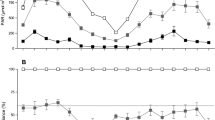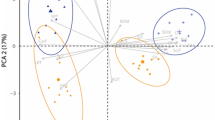Abstract
Tree species have the ability to respond to different levels of light, changing their morphophysiological characteristics. The present study aimed to analyze the influence of light on the growth of three tree species from the Atlantic Forest biome. Growth variables, chlorophyll and carotenoid content, carbohydrates content and leaf anatomical aspects were investigated in the plants kept under two levels of light (80% shading and in full sun) at 60 and 120 days. The results showed that the three species have plastic responses, which allowed them to survive in both light levels. However, Machaerium brasiliense Vogel did not show differences for most growth variables, when kept under shade or full sun, indicating performance similar in both light conditions. Cordia trichotoma (Vell.) Arráb. ex Steud. and Triplaris americana L. presented different responses when maintained at different light levels, such as higher dry biomass, greater thickness of the palisade parenchyma, and greater total thickness of the leaves when kept in full sun. Shade-tolerant species (M. brasiliense) showed higher content of total soluble carbohydrates in the roots of plants kept in shade, representing plasticity in the physiological response of the plant. The two pioneer species have better growth and physiological performance in the higher light intensity treatment. In general, M. brasiliense is less plastic in relation to the other two species. Thus, the pioneers species, C. trichotoma and T. americana, could be used in the early phases of restoration of degraded areas due to their ability to perform better under higher luminosity.







Similar content being viewed by others
References
Almeida ABR, Smidt EC, Amano E (2019) Evolution of anatomical characters in Acianthera section Pleurobotryae (Orchidaceae: Pleurothallidinae). PLoS ONE 14:e0212677. https://doi.org/10.1371/journal.pone.0212677
Araújo LLN, Melo HC, Castiglioni GL, Gonçalves LA (2019) Radiation intensity influencing morphophysiological characteristics in leaves of Tetradenia riparia (Hochst.) Codd. Iheringia Ser Bot 74:e2019001
Borba MR, Scarpare Filho VER, Kluge RA (2005) Levels of carbohydrates in peaches submitted to different intensity of green pruning in tropical climate. Rev Bras Frutic 27:68–72. https://doi.org/10.1590/S0100-29452005000100019
Borges VP, Costa MAPC, Ribas RF (2014) Emergency and initial growth of Tabebuia heptaphylla (Vell.) Toledo in contrasting light environments. Rev Arv 38(3):523–531
Caffarri S, Tibiletti T, Jennings RC, Santabarbara S (2014) A comparison between plant photosystem I and photosystem II architecture and functioning. Curr Protein Pept Sci 15:296–331. https://doi.org/10.2174/1389203715666140327102218
Campoe OC, Iannelli C, Stape JL, Cook RL, Mendes JCT, Vivian R (2014) Atlantic forest tree species responses to silvicultural practices in a degraded pasture restoration plantation: from leaf physiology to survival and initial growth. For Ecol Manage 313:233–242. https://doi.org/10.1016/j.foreco.2013.11.016
Carvalho APF, Bustamante MMC, Kozovits AR, Asner GP (2007) Seasonal variations in leaf pigments and nutrients in “cerrado” species with different phenological patterns. Braz J Bot 30:19–27
César FRCF, Matsumoto SN, Viana AES, Bonfim VER (2014) Initial growth and quality of Pterogyne nitens tull. Seedl under Artif Shad Grad Cienc Florest 24(2):357–366. https://doi.org/10.5902/1980509814573
Clegg KM (1956) The application of the anthrone reagent to the estimation of starch in cereals. J Sci Food Agric 7:40–44
Colmanetti MAA, Barbos LM (2013) Phytosociology and structure of woody overstory from a reforestation with native species at Mogi-Guaçu, São Paulo State. Brazil Hoehnea 40(3):419–435. https://doi.org/10.1590/S2236-89062013000300003
Dahlgren JP, Eriksson O, Bolmgren K, Strindell M, Ehrlé J (2006) Specific leaf area as a superior predictor of changes in field layer abundance during forest succession. J Veg Sci 17:577–582. https://doi.org/10.1111/j.1654-1103.2006.tb02481.x
Daryaei A, Sohrabi H, Puerta-Piñero C (2019) How does light availability affect the aboveground biomass allocation and leaf morphology of saplings in temperate mixed deciduous forests? New for 50:409–422. https://doi.org/10.1007/s11056-018-9666-0
Dickison WC (2000) Integrative Plant Anatomy. Academic Press, USA
Dutra TR, Massad MD, Santana RC (2012) Physiological parameters in seedlings of copaiba under different shade conditions and substrates. Cienc Rural 42:1212–1218
Flores-Cruz M, Santana-Lira HD, Koch SD, Grether R (2004) Taxonomic significance of leaflet anatomy in Mimosa (Leguminosae, Mimosoideae). Syst Bot 29:892–902
Givnish TJ (1988) Adaptation to sun and shade: a whole-plant perspective. Aust J Plant Physiol 15:63–92
Gyimah R, Nakao T (2007) Early growth and photosynthetic responses to light in seedlings of three tropical species differing in successional strategies. New for 33:217–236. https://doi.org/10.1007/s11056-006-9028-1
Gonçalves JFC, Marenco RA, Vieira G (2001) Concentrations of photosynthetic pigments and chlorophyll fluorescence of Swietenia macrophylla king and Dipteryx odorata Aubl. Willd. under two light environments. Braz J Plant Physiol 13:149–157
Henrique PC, Alves JD, Deuner S, Goulart PFP, Livramento DE (2011) Physiological aspects of seedling development of coffee grown under colored screens. Pesqui Agropecu Bras 46:458–465
Haase DL (2008) Understanding forest seedling quality: measurements and interpretation. Tree Planters’ Notes 52:24–30
Ivancich HS, Lencinas MV, Pastur GJM, Esteban RMS, Hernández L, Lindstrom I (2014) Foliar anatomical and morphological variation in Nothofagus pumilio seedlings under controlled irradiance and soil moisture levels. Tree Physiol 32:554–564. https://doi.org/10.1093/treephys/tps024
Johansen DA (1940) Plant microtechnique. McGraw-Hill, New York
Kleiman D, Aarssen LW (2007) The leaf size/number trade-off in trees. J Ecol 95:376–382
Lambers H, Chapin FS III, Pons TL (2008) Plant physiological ecology. Springer Verlag, New York
Lichtenthaler HK (1987) Chlorophylls and carotenoids: pigments of photosynthetic biomembranes. Method Enzymol 149:350–382
Lima JD, Silva BMS, Moraes WS, Dantas VAV, Almeida CC (2008) Effects of luminosity on the growth seedlings of Caesalpinia ferrea Mart. ex Tul. (Leguminosae, Caesalpinoideae). Acta Amazon 38:5–10
Lima MAO, Mielke MS, Lavinsky AO, França S, Almeida AAF, Gomes FP (2010) Growth and phenotypic plasticity of three woody species with potential use in agroforestry systems. Sci for 38:527–534
Lima RAF, Mori DP, Pitta G, Melito MO, Bello C, Magnago LF, Zwiener VP, Saraiva DD, Marques MCM, Oliveira AA, Prado PI (2015) How much do we know about the endangered Atlantic Forest? Reviewing nearly 70 years of information on tree community surveys. Biodivers Conserv 24:2135–2148. https://doi.org/10.1007/s10531-015-0953-1
Lorenzi H (2014) Árvores brasileiras: manual de identificação e cultivos de plantas arbóreas do Brasil. 6ed. São Paulo: Nova Odessa/Plantarum
Marin M, Blandino C, Laverack G, Toorop P, Powe AA (2019) Responses of Primula vulgaris to light quality in the maternal and germination environments. Plant Biol 21:439–448. https://doi.org/10.1111/plb.12849
Mishio M, Kawakubo N (2014) Variations in leaf morpho-anatomy and photosynthetic traits between sun and shade populations of Eurya japonica (Pentaphylacaceae) whose seeds are dispersed by birds across habitats. Plant Spec Biol 30(2):147–158. https://doi.org/10.1111/1442-1984.12045
Mota LHS, Scalon SPQ, Mussury RM (2013) Osmotic conditioning and light on seed germination and growth of seedlings Anadenanthera falcata Benth. Speg Rev Bras Plantas Med 15:655–663
Nascimento KC, Pastorini LH, Romagnolo MB, Souza LA (2015) Do Eugenia hiemalis seedling leaves under different light conditions develop phenotypic plasticity? Plant Ecol 216:1571–1581. https://doi.org/10.1007/s11258-015-0540-2
Negrelle RRB (2016) Tree species composition and structure in an area representative of “acuri forest” at pantanal matogrossense, Brazil. Cienc Florest 26:589–600. https://doi.org/10.5902/1980509822759
O’Brien TP, Feder N, Mccully MEO (1964) Polychromatic staining of plant cell walls by toluidine blue. Protoplasma 59:368–373
Park Y, Runkle ES (2017) Far-red radiation promotes growth of seedlings by increasing leaf expansion and whole-plant net assimilation. Environ Exp Bot 136:41–49. https://doi.org/10.1016/j.envexpbot.2016.12.013
Piper FI, Reyes-Diáz M, Corcuera LJ, Lusk C (2009) Carbohydrate storage, survival, and growth of two evergreen Nothofagus species in two contrasting light environments. Ecol Res 24:1233–1241
Pompelli MF, Pompelli GM, Cabrini EC, Alves MCJL, Ventrella MC (2012) Leaf anatomy, ultrastructure and plasticity of Coffea arabica L. in response to light and nitrogen. Biotemas 25:13–28
Poorter L, Kitajima K (2007) Carbohydrate storage and light requirements of tropical moist and dry forest tree species. Ecol 88(4):1000–1011
Portes MT, Damineli DSC, Ribeiro RV, Monteiro JAF, Souza GM (2010) Evidence of higher photosynthetic plasticity in the early successional Guazuma ulmifolia Lam. Compared to the late successional Hymenaea courbaril L. grown in contrasting light environments. Braz J Biol 70:75–83
Prutsch J, Schardt A, Schill R (2000) Adaptations of an orchid seed to water uptake and –storage. Plant Syst Evol 220:69–75
Rozendaal DMA, Hurtado VH, Poorter L (2006) Plasticity in leaf traits of 38 tropical tree species in response to light; relationships with light demand and adult stature. Funct Ecol 20:207–216
Sajo MG, Rudall PJ (2002) Leaf and stem anatomy of Vochysiaceae in relation to subfamilial and suprafamilial systematics. Bot J Linn Soc 138:339–364
Sanches MC, Marzinek J, Bragiola NG, Nascimento ART (2017) Morpho-physiological responses in Cedrela fissilis Vell. submitted to changes in natural light conditions: implications for biomass accumulation. Trees 31:215–227. https://doi.org/10.1007/s00468-016-1474-6
Santos MS, Feijó NSA, Secco TM, Mielke MS, Gomes FP, Costa LCB, Silva DC (2014) Effects of shading on leaf anatomy of Gallesia integrifolia (Spreng) Harms and Schinnus terebinthifolius Raddi. Rev Bras Plantas Med 16:89–96
Santos OO, Mendes KR, Martins SVC, Batista-Silva W, Santos MA, Figueirôa JM, Souza ER, Fernandes D, Araújo WL, Pompelli MF (2019) Physiological parameters and plasticity as key factors to understand pioneer and late successional species in the Atlantic Rainforest. Acta Physiol Plant 41:145. https://doi.org/10.1007/s11738-019-2931-9
Scalon SPQ, Mussury RM, Rigoni MR, Filho HS (2003) Initial growth of Bombacopsis glabra (Pasq.) A. Robyns seedlings under shading conditions. Rev Árvore 27:753–758
Song J, Cao K, Hao Y, Song S, Su W, Liu H (2019) Hypocotyl elongation is regulated by supplemental blue and red light in cucumber seedling. Gene 707:117–125
Sultan SE (2003) Phenotypic plasticity in plants: a case study in ecological development. Evol Dev 5:25–33
Swaine MD, Whitmore TC (1988) On the definition of ecological species groups in tropical rain forests. Vegetatio 75:81–86
Tang H, Hu YY, Yu W-W, Song LL, Wu J-S (2015) Growth, photosynthetic and physiological responses of Torreya grandis seedlings to varied light environments. Trees 29:1011–1022. https://doi.org/10.1007/s00468-015-1180-9
Thadani R, Berlyn GP, Ashton MS (2009) A Comparison of leaf physiology and anatomy of two Himalayan Oaks in response to different light environments. J Sustain for 28:74–91
Thayer SS, Bjorkman O (1990) Leaf Xanthophyll content and composition in sun and shade determined by HPLC. Photosynth Res 23:331–343
Valladares F, Wright J, Lasso E, Kitajima K, Pearcy RW (2000) Plastic phenotypic response to light of 16 congeneric shrubs from a panamanian rainforest. Ecology 81:1925–1936
Valladares F, Niinemets Ü (2008) Shade tolerance, a key plant feature of complex nature and consequences. Annu Rev Ecol Evol Syst 39:237–257
Vieira TO, Laje-Pinto F, Ribeiro D, Alencar T, Vitoria A (2011) Light stress in jequitibá-rosa seedlings (Cariniana legalis, Lecythidaceae): monitoring photosynthetic acclimation capacity under two light intensities. Vértices 13:129–142
Acknowledgements
The authors would like to thank the Coordenação de Aperfeiçoamento de Pessoal de Nível Superior (CAPES) for the scholarship of the first author of this work.
Author information
Authors and Affiliations
Contributions
FTP was the main author, designed the experiments, performed the experiments, wrote the manuscript, and analyzed the data. LAS analyzed anatomical and morphological characteristics. CB analyzed the data for carbohydrates and assisted in designing the figures. TM performed the experiments with carbohydrates. MBR: collected plant material and identified the plants. LHP designed the experiments, assisted in the writing of the manuscript, and analyzed the data. All authors have read and approved the final version of the manuscript.
Corresponding author
Ethics declarations
Conflict of interest
The authors declare that they have no conflict of interest.
Additional information
Publisher's Note
Springer Nature remains neutral with regard to jurisdictional claims in published maps and institutional affiliations.
Rights and permissions
About this article
Cite this article
Firmino, T.P., de Souza, L.A., Barbeiro, C. et al. Influence of the light on the morphophysiological responses of native trees species of the semidecidual stational forest. Braz. J. Bot 44, 963–976 (2021). https://doi.org/10.1007/s40415-021-00754-4
Received:
Revised:
Accepted:
Published:
Issue Date:
DOI: https://doi.org/10.1007/s40415-021-00754-4




